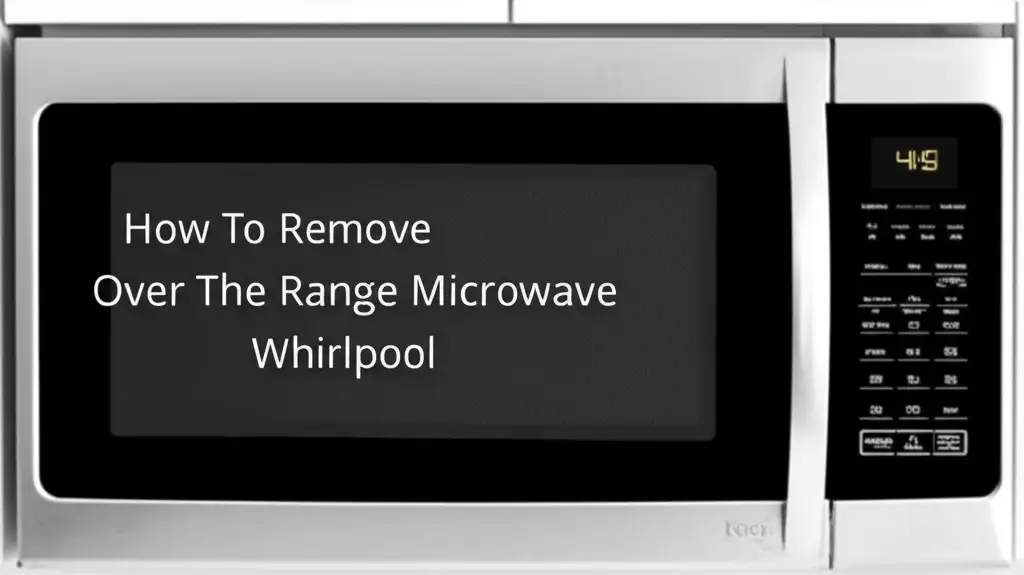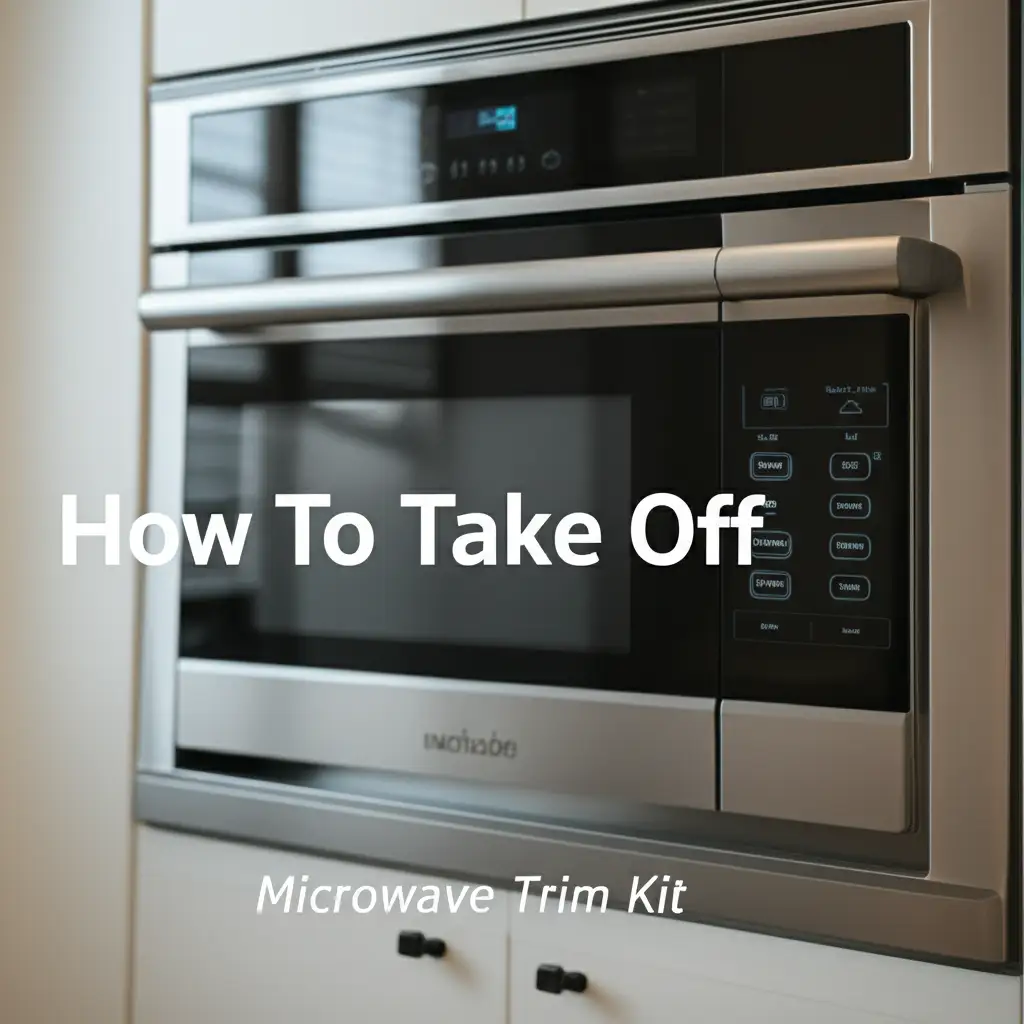· Todd Martin · Home Appliances · 19 min read
How To Remove Over The Range Microwave Whirlpool

Expert Guide: How To Remove Your Whirlpool Over-the-Range Microwave
Has your trusty Whirlpool over-the-range microwave seen better days? Perhaps you are upgrading your kitchen or simply need to replace a faulty unit. Knowing how to safely and correctly remove your Whirlpool over-the-range microwave is a valuable skill. This task may seem daunting at first glance. However, it becomes manageable with the right approach and proper preparation.
I remember when I first decided to tackle this project myself. I felt a mix of excitement and apprehension. This guide breaks down each step into simple, actionable instructions. We will cover everything from essential safety precautions to disconnecting wires and lowering the appliance. You will learn about the necessary tools and how to prepare your kitchen. By the end, you will feel confident in your ability to remove your microwave. This detailed article ensures a smooth and secure removal process for your Whirlpool appliance.
Takeaway
- Always disconnect power before starting any work on the microwave.
- Gather all necessary tools and safety gear beforehand.
- Secure the microwave from below before unscrewing it from above.
- Enlist a helper for the lifting and lowering steps to prevent injury.
- Handle electrical connections and ventilation ducts carefully.
To remove an over-the-range Whirlpool microwave, first unplug it or turn off its circuit breaker. Then, remove any filters, glass tray, and exhaust grille. Locate and remove the screws securing the microwave to the upper cabinet and the mounting plate on the wall. Finally, carefully lift and slide the microwave off its wall bracket with a helper.
Prioritizing Safety: Essential First Steps Before Microwave Removal
Safety is paramount when working with electrical appliances. Before you touch a single screw, you must ensure the power supply is completely off. Ignoring this step risks electrical shock, which can be very dangerous. I always make this my absolute first priority. This step protects both you and your home.
Begin by locating the circuit breaker that controls your kitchen microwave. This breaker is usually labeled in your electrical panel. If your panel labels are unclear, you can turn off the main breaker for your entire home. This ensures no power reaches the microwave during removal. Once you have flipped the breaker, test the microwave by attempting to turn it on. The display should be dark, and the microwave should not respond. This confirms the power is off.
Next, you must wear appropriate safety gear. Heavy-duty work gloves protect your hands from sharp edges or pinch points. Safety glasses shield your eyes from dust or debris that might fall during the removal process. I learned early on that a small precaution can prevent a big problem. Also, consider placing a drop cloth or old blanket on your stovetop or countertop below the microwave. This protects surfaces from scratches or damage during removal. It also helps catch any falling debris.
Clear the work area around the microwave. Remove any items from the stovetop, such as pots, pans, or food. Ensure the area directly below the microwave is free of obstacles. This creates a safe space for you to maneuver the appliance. Having a clear path also prevents accidental trips or falls. A tidy workspace is a safe workspace.
Finally, think about ventilation. Many over-the-range microwaves connect to a ventilation system. You might deal with a vent hood, charcoal filters, or a duct leading outside. Understanding your microwave’s ventilation setup helps you anticipate what you will encounter during removal. Some models exhaust directly into the room, while others connect to ductwork. Being aware of this helps you plan for disconnecting it later. This initial safety and preparation phase lays the groundwork for a smooth removal.
Gathering Your Tools: What You Need for Whirlpool Microwave Removal
Having the right tools makes any DIY project much easier and safer. For removing a Whirlpool over-the-range microwave, a specific set of tools is essential. I always lay out all my tools before I begin. This saves time and prevents frustration during the process. You do not want to be scrambling for a screwdriver when you are holding a heavy appliance.
First, you will need a Philips head screwdriver. Many Whirlpool microwaves use Philips head screws for their various components. You will use this for accessing internal parts, removing grilles, or detaching certain covers. A flathead screwdriver might also be useful for prying open stubborn panels or testing outlets. It is good to have both sizes on hand for unexpected needs.
Next, a power drill with a set of screwdriver bits is very helpful. This speeds up the removal of numerous screws, especially those holding the mounting plate. Ensure you have bits that match the screw heads you find. Some models might use hex head screws, so a nut driver set or socket wrench could be necessary. Having the right size socket will prevent stripping screw heads. This is especially true for the long bolts that often secure the microwave from the top cabinet.
You will definitely need a stud finder. An over-the-range microwave mounts to wall studs for support. Locating these studs is critical for both removal and future installation. This tool helps you identify the hidden wooden framework behind your drywall. It ensures you know where the main support points are. You will also use this when you can install an over-the-range microwave.
A step stool or a sturdy ladder is indispensable. These microwaves are typically mounted above a stovetop. You need to reach the top of the appliance and the cabinet above it comfortably and safely. Make sure your ladder is stable and placed on a level surface. A second person is not a tool, but they are absolutely necessary. This person will help support the microwave’s weight as you detach it. They ensure the microwave does not fall, protecting both the appliance and you. Without a helper, this task becomes extremely difficult and dangerous.
Finally, gather a utility knife or box cutter. This helps if you need to cut any sealant or tape around the microwave. You may also need a pair of pliers for gripping wires or fasteners. A level can be useful to check the mounting plate’s position if you plan to reinstall. A pen and paper can help you make notes if needed. Having all these items ready before you start will make the job much smoother. This preparation is key for efficient and safe removal.
Disconnecting Power and Preparing the Area
Before any physical removal begins, completely disconnecting the power is crucial. This step protects you from electrical hazards. I cannot stress enough how important this is for your safety. Always prioritize this action above all else.
First, locate your home’s electrical service panel. This panel is usually in a utility closet, basement, garage, or laundry room. Find the circuit breaker labeled for your kitchen or specifically for the microwave. Whirlpool microwaves typically operate on a dedicated 20-amp circuit. Flip the circuit breaker to the “OFF” position. If your breakers are not labeled, you might need to turn off the main breaker for the entire house. This guarantees no power flows to the microwave. After flipping the breaker, go back to the kitchen. Try to power on the microwave. The display should be blank, and the unit should show no signs of life. This confirms the power is off and it is safe to proceed.
Next, clear the area directly beneath and around the microwave. Remove anything from your stovetop or countertop. Pots, pans, dish racks, and decorative items should be moved away. This creates a clear working space. Place a thick blanket or old cardboard boxes on the stovetop. This protects the range from scratches or damage during the removal process. It also provides a cushioned landing spot if something slips.
Now, prepare the microwave itself. Remove the glass turntable plate and any roller rings from inside the microwave. These items can break easily or add unnecessary weight. Open the microwave door and ensure nothing is left inside. Close the door firmly. Some microwaves have a ventilation grille on top or front. You might need to remove this grille to access mounting screws or filters. This often involves unscrewing small screws or releasing clips.
Additionally, locate any filters that are part of the microwave’s ventilation system. These might be grease filters underneath the microwave or charcoal filters inside the unit behind the grille. It is a good idea to remove these. They can be cleaned or replaced later. Sometimes, removing these also grants access to hidden screws or connections. Understanding how to clean over the range microwave filters can be useful for future maintenance. Take a moment to inspect the area around the microwave. Look for any caulking or sealant applied where the microwave meets the cabinet or wall. You may need a utility knife to carefully score and cut through this sealant. This will prevent damage to your cabinets or wall when you pull the microwave away.
Accessing and Detaching the Mounting System
After ensuring safety and preparing the area, the next critical step is to access and detach the microwave’s mounting system. This involves finding and removing the hidden screws that hold the appliance in place. I found this part to be the most challenging because the screws are often out of sight. Most over-the-range Whirlpool microwaves use a combination of top cabinet screws and a wall mounting plate.
Start by opening the upper cabinet directly above the microwave. Look inside the cabinet floor. You should see two to three large bolts or screws. These bolts extend down through the cabinet floor and thread into the top of the microwave unit. These are the primary fasteners that support the microwave’s front weight. Use a power drill or a socket wrench with the appropriate bit to unscrew these bolts. Be careful not to strip the screw heads. As you loosen them, the microwave might start to sag slightly from the front. This is normal.
Next, you need to deal with the electrical connection. For most Whirlpool models, the power cord plugs into an outlet located inside the upper cabinet. Reach into the cabinet and locate the electrical cord. Carefully unplug the cord from the outlet. If your microwave is hardwired, you will need to access the junction box. This is usually inside the upper cabinet or behind the microwave. If it is hardwired, you might want to call an electrician. Tampering with hardwired connections without proper knowledge can be dangerous. Knowing if an over-the-range microwave can be hardwired is helpful for installation, but removal for a hardwired unit needs extra care.
Now, you need to manage the mounting plate. A metal mounting plate or bracket is usually screwed into the wall studs behind the microwave. The microwave hooks onto this plate at the back. This plate supports the microwave’s rear weight. You will not remove this plate yet. It acts as a pivot point for the microwave to swing down. The bolts from the top cabinet are key here. Once these bolts are fully removed, the front of the microwave becomes free.
With the top screws removed and the power disconnected, the microwave is now only held by the wall mounting plate and, often, a slight friction fit with the upper cabinet sides. This is where your helper becomes essential. While one person supports the front and bottom of the microwave, the other can continue to ensure no wires are snagged. The microwave will pivot downwards from the back. It is heavy, so be prepared for its weight. This systematic approach ensures controlled detachment from its secure mounting.
Carefully Lowering and Removing the Appliance
This is the most physically demanding part of the microwave removal process. It requires coordination and strength. Remember, over-the-range microwaves are heavy appliances. Their weight distribution can be awkward. I always make sure my helper is strong and understands the plan before we attempt this step.
With the top cabinet screws removed and the power unplugged, the microwave is now resting on the wall mounting plate. It is essentially hooked onto this plate at the back, acting as a hinge. One person needs to stand directly in front of the microwave, reaching underneath to support its weight. Their hands should be firmly under the base of the microwave. The second person should also be ready to assist, possibly supporting from the side or ensuring the path is clear. This cooperative effort is vital for safe lowering.
Slowly and carefully, the person supporting the front of the microwave should begin to tilt the unit forward and downward. The back of the microwave will slide up and off the mounting plate’s hooks. This motion requires a controlled lift and pivot. As the microwave clears the mounting plate, its entire weight will transfer to the person supporting it. Be prepared for this sudden shift in weight. You might need to briefly rest the microwave on the stovetop or a sturdy surface you have prepared below.
Once the microwave is fully detached from the wall plate, you need to maneuver it out of the space. This might involve tilting it slightly or gently pulling it forward. Be mindful of any ventilation ductwork or electrical wires still connected to the house. If there’s a metal vent duct running from the top of the microwave into the upper cabinet or ceiling, it will likely need to be disconnected at this point. Some ducts simply slide apart, while others may be taped or screwed together. Be gentle to avoid damaging the ductwork, especially if you plan to install a new microwave using the existing vent.
After detaching any remaining ducts, carefully carry the microwave away from the stove area. Place it on a stable surface, like the kitchen floor on a protective blanket, or directly outside if you are ready for disposal. Take a moment to rest and ensure no one is strained. This step often requires the most physical effort. A similar process applies to other brands too; learning how to remove a Panasonic over-the-range microwave or how to remove a Goldstar over-the-range microwave often involves these same core principles. Proper planning and teamwork make this heavy lifting manageable and safe.
Dealing with Ventilation and Exhaust Systems
Over-the-range microwaves often double as kitchen exhaust fans. This means they are connected to a ventilation system. Understanding this system is crucial for proper removal and future installation. I always check the venting type before I even start. This prevents surprises later.
There are typically three types of ventilation setups:
- Recirculating (Ductless): This type filters the air and recirculates it back into the kitchen. These models use charcoal filters. They do not connect to external ductwork. Removing these is simpler as you only deal with the microwave unit itself. You might just see grilles on the top or front that vent air out.
- Vertical Exhaust (Ducted): This is common. Air is pulled up through the microwave, then vented into a duct leading through the cabinet above and out through the roof. You will see a rectangular or round metal duct connecting the top of the microwave to the cabinet.
- Horizontal Exhaust (Ducted): Less common, but some models vent air out through the back of the microwave, directly through the exterior wall. This requires careful disconnection from the wall duct.
If your Whirlpool microwave uses a vertical or horizontal exhaust, you will need to disconnect the ductwork. After you have lowered the microwave, you will see the exhaust port on top or at the back. A metal or plastic duct connects to this port. These ducts are often held in place with foil tape, small screws, or simply slide into position. Carefully remove any tape or screws holding the duct to the microwave’s exhaust port. Then, gently separate the duct from the microwave. Be careful not to bend or damage the ductwork, especially if you plan to reuse it for a new microwave.
Sometimes, the duct runs through a hole in the upper cabinet. If so, inspect the duct connection point within the cabinet. You might need to reach into the cabinet to fully detach the duct section. For vertical ducts, the duct may extend up through the ceiling. You are usually only responsible for disconnecting the part that directly attaches to the microwave. The remaining ductwork in the wall or ceiling can stay unless you plan a major renovation.
After the microwave is fully removed, inspect the remaining ductwork. Ensure it is clear of debris. Check for any damage. If you are installing a new over-the-range microwave, especially a Whirlpool, the new unit will likely connect to the same ductwork. Proper installation of an over the range microwave with vent relies on this existing infrastructure. Understanding and carefully managing the ventilation system ensures your new appliance functions correctly. This also maintains proper airflow in your kitchen.
Cleaning Up and Preparing for a New Installation
Once your Whirlpool over-the-range microwave is successfully removed, the next phase is cleanup and preparation. This step is important for both aesthetics and functionality. A clean space ensures a smooth transition to your new appliance or simply a tidier kitchen. I always take time for a thorough clean. It makes the space feel refreshed immediately.
First, address the area where the microwave was mounted. You will likely find grease, dust, and grime accumulated on the wall and the underside of the upper cabinet. Use a good degreaser or all-purpose cleaner to scrub these surfaces. Pay special attention to the backsplash area. This often collects cooking residue. A clean surface not only looks better but also provides a better foundation for any future installation. You might also find paint discoloration or marks on the wall. These can be touched up with paint if needed.
Next, inspect the wall mounting plate. This is the metal bracket that was screwed into your wall studs. If you plan to install a new over-the-range microwave, you might be able to reuse this plate. Many Whirlpool models use a standard mounting plate. However, it is always best to check the installation instructions for your new microwave. Sometimes, even different models within the same brand require a slightly different plate. If your new microwave comes with its own mounting plate, you will need to remove the old one. Use your drill or screwdriver to unscrew it from the wall studs. Keep the screws for potential future use or dispose of them properly. If you are not installing a new microwave right away, you might want to patch the holes in the wall and paint them.
Consider the disposal of your old microwave. These appliances are large and contain various materials, some of which should not go into regular landfill. Check with your local waste management services for proper disposal methods. Many municipalities have specific guidelines for electronic waste or appliances. Some offer curbside pickup on certain days. Others direct you to specific recycling centers. Local appliance stores or charities sometimes accept old appliances for donation or recycling. Learning how to dispose of an over the range microwave properly is an important environmental responsibility.
Finally, prepare for your new microwave installation, if applicable. Gather the new microwave, its mounting template, and all necessary hardware. Ensure you have located the wall studs where the new microwave will be mounted. Your stud finder will be essential here. You may also need to drill new holes for the mounting plate or for the upper cabinet screws. This preparatory work saves time and avoids frustration during the installation phase. Having a clear, clean, and prepared space makes the next step much more enjoyable.
Troubleshooting Common Issues During Removal
Even with careful planning, you might encounter a few hiccups when removing your Whirlpool over-the-range microwave. Knowing how to troubleshoot these common issues can save you time and frustration. I have faced a few unexpected challenges myself, and a little forethought goes a long way.
One common issue is stripped screws. This often happens with the long bolts inside the upper cabinet or the screws on the mounting plate. If a screw head is stripped, your screwdriver or drill bit will just spin without gripping. First, try a different size or type of bit. Sometimes a slightly larger Philips head or a Torx bit can get enough grip. If that fails, you might need a screw extractor kit. These kits have bits designed to grip and remove stripped screws. Another option, for accessible screws, is to use a pair of vice grips to turn the screw head. Patience is key when dealing with stripped screws.
Another challenge can be a microwave that feels stuck. Even after removing all visible screws, the microwave might not budge. This can happen if there is old caulk or adhesive between the microwave and the cabinet or wall. Use a utility knife to score along any seams where the microwave meets the cabinet or wall. Make sure to cut through any dried caulk. Sometimes, the microwave is just very tightly fitted into the space. Gentle wiggling and a small amount of leverage can help break it free. Remember to have your helper ready to support the weight as soon as it loosens.
Electrical connections can also present issues. If your microwave is hardwired instead of plug-in, do not attempt to disconnect it unless you are comfortable and experienced with electrical work. Hardwired connections require turning off the main breaker and carefully separating wires within a junction box. If you are unsure, it is always safer to call a qualified electrician. This prevents electrical shock and ensures proper re-connection for the new unit. For the future, you might consider if an over-the-range microwave can be hardwired for your next installation.
Finally, dealing with awkward weight and size is common. These appliances are heavy and cumbersome. This is why a second person is absolutely non-negotiable. If you find yourself struggling, stop and reassess. Adjust your grip or the position of your helper. Ensure you have firm footing. Do not rush the process. Taking breaks if you feel fatigued is a good idea. Knowing how to mount an over the range microwave without a cabinet gives you a deeper understanding of the mounting mechanisms, which can help in removal. Being prepared for these common issues will make your Whirlpool microwave removal a smoother experience.
- Whirlpool microwave removal
- over the range microwave
- appliance DIY
- kitchen renovation
- microwave replacement





